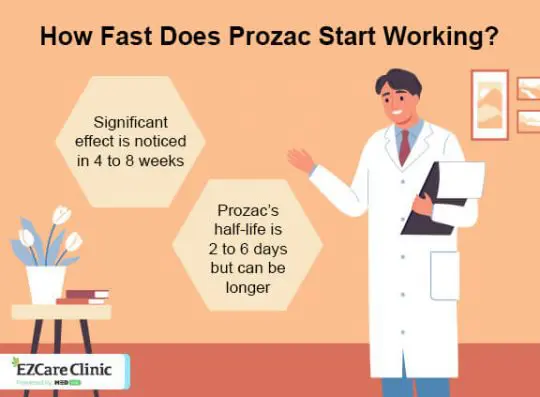The medications listed on this website are provided for informational purposes only. Their inclusion does not guarantee that they will be prescribed to any individual, as treatment decisions are ultimately at the discretion of healthcare providers. This list is not exhaustive, and healthcare providers may prescribe other medications, including non-stimulant options, based on the patient's unique health circumstances and needs.
Prozac, a brand name for fluoxetine, is a prescription medication in the class of selective serotonin reuptake inhibitors (SSRIs). This antidepressant is FDA-approved for:
- Major depressive disorder (MDD).
- Anxiety disorders such as panic disorder.
- Eating disorders like bulimia nervosa and anorexia.
- Obsessive-compulsive disorder (OCD).
- Premenstrual dysphoric disorder (PMDD).
Prozac’s half-life is approximately two to six days but can be longer if the patient has used it for a long time. Several factors determine Fluoxetine’s half-life and its eradication from the system. In this post, let’s review the most important ones.
Consult EZCare doctors online to get a diagnosis and personalized treatment.
What is Prozac?
Prozac is one of the most commonly prescribed antidepressants, and the World Health Organization includes it in the List of Essential Medicines. As an SSRI, Prozac affects the brain’s neurotransmitters — increases serotonin levels. Serotonin aids cognition and memory and stabilizes emotions, mood, and sleep.
Though a common antidepressant, Fluoxetine does not work for everyone. A user may experience severe side effects or find the medication unhelpful, hence the need to discontinue its use. If the doctor decides to switch a patient to another antidepressant, the concern would be how long Prozac would remain in the system before total elimination.
Prozac Dosage
Prozac is available as a syrup, solution, or pill. The usual range of dosage is from 20 to 60 mg per day. Twenty milligrams per day is the normal dose for depression but can be increased to a maximum of 60 mg in case of a severe mental disorder. The medication should be taken at the same time daily, and a patient must follow the doctor’s instructions on its usage.
How Long Does It Take for Prozac to Work?
Fluoxetine takes about four to eight weeks to affect the user. Once absorbed in the body, a person might experience some side effects that resolve by themselves after the system adjusts to the medication.

The side effects of Prozac include:
- Anxiety or nervousness
- Decrease in sexual drive
- Dizziness, tremors, or shaking
- Dry mouth, sweating, or hot flashes
- Fatigue, weakness, or pain
- Flu-like symptoms or stuffy nose
- Headache or pain
- Indigestion or a change in appetite
- Insomnia or strange dreams
- Vision changes
- Weight changes
In case of experiencing any severe side effects, a person should consult the doctor. Prozac should be discontinued gradually and with the guidance of a doctor to prevent severe withdrawal symptoms.
Consult your prescriber if you experience any side effects to get help and adjust your treatment plan.
How Long Does Prozac Stay in Your System?
After intake, Prozac is absorbed in the gut, metabolized in the liver, and then circulates in the bloodstream. Norfluoxetine, the metabolite in Prozac, stays longer in the body as it has about a double
However, it is essential to note some
Factors That Affect How Quickly Prozac Leaves the Body
It’s important to work with the doctor to discontinue Prozac safely. Regardless, several factors determine how long Fluoxetine stays in the body before total elimination. These include:
- Age. It takes longer for Prozac to leave the system in elder patients.
- Kidney and liver impairments. Kidney and liver health conditions influence Prozac’s elimination from the system since the medication is eradicated primarily in the urine. If the two organs are impaired, they prolong the half-life of Prozac.
- Medication history. Fluoxetine has a longer half-life in an extended user’s system, hence taking long to eliminate compared to a short-time user.
- Genetic and metabolism factors. A slow metabolism process stretches Prozac’s half-life.
After Fluoxetine is eliminated from the body, the symptoms of the mental disorder can reoccur. However, a gradual withdrawal minimizes the risk of the return of symptoms.

Prozac Withdrawal Symptoms
Prozac withdrawal effects take time due to the medication’s long half-life. Sudden discontinuation of the antidepressant may cause the following withdrawal symptoms:
- Dizziness
- Headache
- Irritability
- Nausea or vomiting
- Nightmares
- Prickling and tingling sensations on the skin
Conclusion
Prozac is a common prescription medication that is effective in treating psychiatric disorders. Prozac’s long half-life implies the medicine has significant effects on the system and also takes longer to eliminate. Therefore, it is vital to follow the doctor’s guidelines and seek a review in case of adverse side effects or unsuccessful treatment.
Sources
- Clinical pharmacokinetics of fluoxetine. (1994)
Source link - False-positive interferences of common urine drug screen immunoassays: a review. (2014)
Source link
Expert help for mental health issues.
Get treatment from licensed healthcare professionals.







